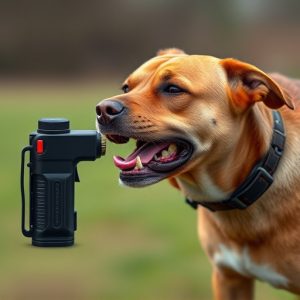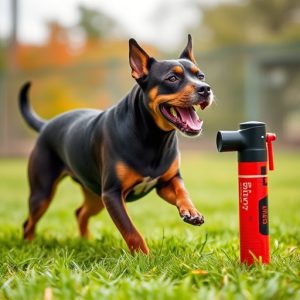Mace Canine Spray: Effective Range & Safety Guide for Animal Control
Animal control professionals use the Mace Canine Spray, with a 3-4 meter range and 1-2 square meter…….
Animal control professionals use the Mace Canine Spray, with a 3-4 meter range and 1-2 square meter cone-shaped cloud, to temporarily incapacitate aggressive dogs without causing permanent harm. Its adjustable spray pattern width—up to 9 meters in narrow stream mode—enables versatile defense strategies against multiple animals or specific close-range encounters. Safety and proper training are paramount; users must target eyes and faces while ensuring good ventilation to avoid inhalation risks. Local laws regarding pepper spray use, including Mace canine spray, vary by region, requiring compliance with permits, age restrictions, and reporting requirements.
“Discover the power of animal control pepper spray, a non-lethal solution for managing aggressive wildlife. In this comprehensive guide, we explore ‘Understanding Animal Control Pepper Spray’ and delve into specific products like Mace Canine Spray, highlighting its key features and impressive 30-foot effective range. Learn about spray pattern width to ensure optimal coverage during deployment. Additionally, we cover essential safety measures and legal considerations for responsible use. Get ready to navigate the wilderness with confidence.”
- Understanding Animal Control Pepper Spray: A Comprehensive Overview
- Mace Canine Spray: Key Features and Effective Range
- Choosing the Right Spray Pattern for Optimal Coverage
- Safety Measures and Legal Considerations for Pepper Spray Use
Understanding Animal Control Pepper Spray: A Comprehensive Overview
Animal control pepper spray, often referred to as mace, is a non-lethal deterrent designed to temporarily incapacitate animals and facilitate their capture or removal. Understanding its effective range and pattern width is paramount for professionals in this field. The typical Mace Canine Spray has a range of approximately 3 to 4 meters (10 to 13 feet), making it suitable for controlling medium to large sized animals.
The spray pattern width varies among brands but generally forms a cone-shaped cloud when discharged, covering an area of about 1 to 2 square meters at the base. This wide yet focused coverage allows animal control officers to swiftly target and subdue problem animals without causing permanent harm. The fast-acting agent irritates the eyes, nose, and throat, leading to temporary disorientation and reduced mobility, enabling safe capture or relocation.
Mace Canine Spray: Key Features and Effective Range
The Mace Canine Spray is a powerful tool designed for law enforcement and animal control professionals to subdue aggressive dogs from a safe distance. Its primary feature is the narrow spray pattern width, allowing users to target specific areas, minimizing harm to bystanders and non-threatening animals. This precision is achieved through advanced aerosol technology, ensuring the spray reaches its intended mark effectively.
The effective range of Mace Canine Spray varies depending on factors like wind conditions and terrain but typically extends up to 30 feet (9 meters). This range provides officers with a crucial buffer zone, enabling them to control situations without requiring physical contact. The spray’s potent formula, combined with the narrow beam, makes it a reliable solution for managing potentially dangerous canine encounters.
Choosing the Right Spray Pattern for Optimal Coverage
When selecting an animal control pepper spray, understanding the spray pattern is key to ensuring effective coverage and optimal performance. Different models offer various spray patterns, each designed for specific use cases. For instance, a wide spray pattern provides a broader reach, ideal for deterring multiple animals or covering large areas, while a concentrated stream is more suitable for close-range encounters with aggressive dogs.
The Mace Canine Spray, known for its reliability and ease of use, typically features an adjustable spray pattern width. This allows users to customize the spray projection from a wide fan shape to a narrow, direct stream. Such versatility enables individuals to adapt their defense strategy based on the situation at hand, be it a sudden attack from a wild animal or the need to deter a dog with intense protectiveness towards its territory.
Safety Measures and Legal Considerations for Pepper Spray Use
When using pepper spray for animal control, safety is paramount. It’s crucial to understand that pepper spray, like Mace canine spray, is a powerful irritant designed to temporarily disable rather than harm. Users must be trained and certified to ensure they employ the correct technique, aiming for the eyes and face to maximize effectiveness while minimizing cross-contamination risk. Proper ventilation is essential during application to prevent inhalation by both the user and nearby individuals or pets.
Legal considerations vary widely depending on location, with different regions having distinct regulations regarding pepper spray use. Some areas restrict its use only to law enforcement, while others permit it for animal control purposes under certain conditions. Users should be aware of local laws and obtain any necessary permits before deploying pepper spray. Understanding the legal framework around Mace canine spray or similar products helps ensure compliance and protects against potential consequences. Factors such as age restrictions, permitted application scenarios, and reporting requirements can differ significantly across jurisdictions.
Animal control pepper spray, particularly the Mace Canine Spray, offers a non-lethal solution for managing aggressive animals. Understanding its effective range and choosing the right spray pattern is crucial for optimal coverage and safety. The Mace Canine Spray’s key features, including its 20-foot (6 meter) range and wide spray pattern, ensure swift and effective animal deterrence. However, always adhere to legal considerations and safety measures when using pepper spray to protect both humans and animals.


